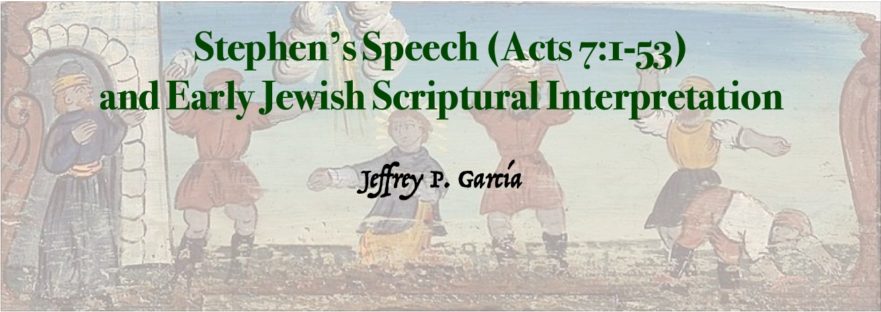How to cite this article: Jeffrey P. García, “Stephen’s Speech (Acts 7:1-53) and Early Jewish Scriptural Interpretation,” Jerusalem Perspective (2022) [https://www.jerusalemperspective.com/25184/].
The interest in early Jewish interpretation of scripture[1] has grown considerably with the publication of the Dead Sea Scrolls.[2] The interpretative traditions attested at Qumran redirected scholars’ attention afresh to the corpus of post-biblical Jewish literature compiled in the so-called Pseudepigrapha and Apocrypha. As studies have shown, the New Testament plays an important role in this discussion.[3] Indeed, examinations of scriptural interpretation in the New Testament provide examples of ancient Jewish interpretative methodology and known traditions that are paralleled in other Second Temple and rabbinic texts—as well as, previously unknown traditions. “Stephen’s Speech” (Acts 7:1-53) is a key example of both, namely, a witness to ancient Jewish exegetical style and a treasury of Second Temple interpretative traditions. While a full examination of the longest speech in the New Testament is beyond our scope here, we will highlight several verses that preserve ancient Jewish approaches to scripture and a complex of passages, towards the end, that preserve allusions to and exegesis of the Hebrew Scriptures.
Paid Content
Premium Members and Friends of JP must be logged in to access this content: Login
If you do not have a paid subscription, please consider registering as a Premium Member starting at $10/month (paid monthly) or only $5/month (paid annually): Register
One Time Purchase Rather Than Membership
Rather than purchasing a membership subscription, you may purchase access to this single page for $1.99 USD. To purchase access we strongly encourage users to first register for a free account with JP (Register), which will make the process of accessing your purchase much simpler. Once you have registered you may login and purchase access to this page at this link:

- [1] The use of “scripture” and “scriptural,” rather than “Bible” and “biblical,” is intended to refer to texts that were authoritative—in varying degrees— to diverse ancient Jewish communities without presuming that the collection that we know as the Bible, Hebrew Bible, or Old Testament was static and in the form that exists now. ↩
- [2] See especially Moshe Bernstein, “The Contribution of the Qumran Discoveries to the History of Early Biblical Interpretation,” in The Idea of Biblical Interpretation: Essays in Honor of James L. Kugel (Leiden: Brill, 2004), 215-38. ↩
- [3] For example, R. Steven Notley’s “Jesus’ Hermeneutical Method in the Synagogue of Capernaum,” in Early Christianity and Intertextuality – Vol. 2: Exegetical Studies, eds. Craig Evans and Daniel Zacharias, LNTS 392 (London: Continuum, 2009), 46-59; also, idem and Jeffrey P. García, “Hebrew-Only Exegesis: A Philological Approach to Jesus’ Use of the Hebrew Bible,” in The Language Environment of First Century Judaea: Jerusalem Studies in the Synoptic Gospels—Volume Two, ed. Randall Buth and R. Steven Notley, JCP 26 (Leiden: Brill, 2014), 347-74; Lawrence H. Schiffman, “Biblical Exegesis in the Passion Narratives and in the Dead Sea Scrolls,” in Biblical Interpretation in Judaism and Early Christianity ed. Isaac Kalimi and Peter J. Haas (London: T&T Clark, 2006), 117–130; Serge Ruzer, Mapping the New Testament (Leiden, Brill 2007); Michael R. Whitenton, “Rewriting Abraham and Joseph: Acts 7:2-16 and Jewish Exegetical Traditions,” NT 54/2 (2012): 149-167; Dulcinea Boesenberg, “Retelling Moses’s Killing of the Egyptian: Acts 7 in Its Ancient Jewish Context,” BTB 48/3 (2018): 148-156, et. al. ↩































































































